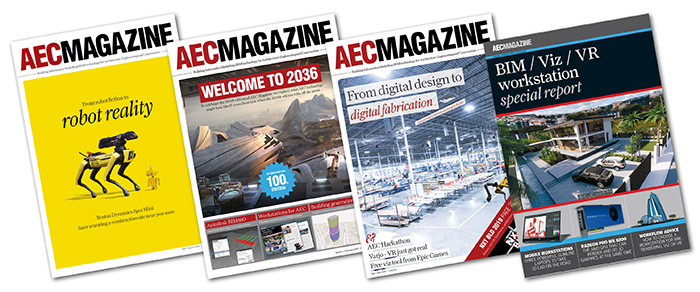If a digital twin – or in the future, National Digital Twin and smart cities – is all about connected data ecosystems, what happens when data ownership and management are brought into the equation? Who owns the data, and how do we ensure the information can still be accessed in 10-30 years’ time. Stuart Bell makes a case for greater clarity around data and accountability, stressing the need for companies to be clear on whose role it is to maintain it
The construction industry is highly complex and slow to change. With the industry facing skills shortages and anaging workforce just as the country needs critical infrastructure investment to boost the economy, the ways in which we design, procure and construct are under pressure to evolve.
For the industry to confront these challenges there is a general agreement that the way in which it works needs to change. A culture of genuine collaboration and the sharing of information must happen, and digital technology could be the answer. Digitisation is helping project teams and asset owners drive efficiencies through more effective modelling, design, procurement, mobilisation, construction and operation, yet amongst this there is a great deal of confusion as to who owns data.
These issues should be addressed at the earliest stage of the project, within the contract along with any interoperability expectations. Generally, as it is the client that is procuring the information, they must ensure they specify responsibilities or have the resources and knowledge to manage their model to maintain it. If we look into the not too distant future, it may will be that autonomous systems and robots will be using it for operations and maintenance. Document naming conventions and standards create a futureproof information management framework and are fundamental to the creation of scalable, interoperable ecosystems. The information needs to be updatable and maintainable to feed the digital twin, otherwise it will be a stagnant model.
Security is another significant consideration. If we have a connected data ecosystem that shares data, the client again has to specify what data is required to be shared, and ensure data is managed correctly to prevent risk from supplier insolvency as well as cyber threats.
What about asset owners insourcing data?
Generally speaking, the fragmentation of the construction supply chain complicates data ownership, as at an information management level there can be a great deal of disconnection. When it comes to maintaining a full, clear audit trail of communications, it is incumbent upon the contracting parties to perform this duty, subject to their contractual responsibilities. Yet where there is disconnection, piecing together disparate datasets in order to identify them is all the more complicated, making for a complex tapestry that takes months to complete.

Pushing the responsibility of information management onto the supply chain is not a new phenomenon. This behaviour started back in the 90s with the advent of the Private Finance Initiative. This specific public procurement route shifted responsibility out onto the construction supply chains; meaning they were in charge of designing, building and operating privately financed capital projects. The government consequently cut their members of staff (construction information management professionals) who specialised in this field and outsourced responsibility to the fragmented construction industry.
Moreover, ahead of the 2016 BIM Level 2 mandate, government advisors noticed the significant inefficiencies in the industry, and suggested digitalised processes and standardisation around common naming conventions would allow 40% of construction project costs to be saved. Whilst ideal in theory, in reality it was problematic to force the industry to take ownership of a 40% cost saving, especially when the industry is perpetually working off tight margins. To alleviate the burden of this mandate the industry cut corners, which had all sorts of negative implications on building delivery and quality.
Where outsourcing becomes a problem
If project and asset data is fragmented and then for some reason compromised e.g. the principal contractor falls into administration, all of the project information which is hosted and managed is locked-in, and clients and other project parties are locked out from accessing it. The onus is then on the asset owner (client) and not the contractor to retrieve and re-procure the thousands of datasets from different parties involved on the project. As an alternative to re-purchasing the data from the design team or supply chain, the built asset may need to be re-surveyed to establish the required data, and this can incur further costs.
What is lacking here is client ownership of a clear, accessible audit trail to ensure all transactions throughout a project and asset’s lifecycle are maintained. Rather than outsource the information management service, wouldn’t it be better for the asset owner to insource the data so they have access to the information and audit trail? Can pressures on the supply chain be lightened by providing a clear destination for data drops and information handover?
What are the alternatives?
Most organisations procure information differently and have multiple systems with different users managing data, and these are some of the main reasons why data can be so fragmented. Often it is better to have a single version of the data in one place to be accessed by many, as it avoids duplication and ensures each piece of data is in its truest and trusted form.
Providing a single version of the truth for all project and asset data, a project and asset information management system or common data environment (CDE) enables information to be accessed and shared by all parties throughout an asset’s lifecycle. A CDE enables all parties to securely communicate and collaborate on a structured workflow basis whilst simultaneously continuing a robust audit trail. It might be worthwhile to mention that on most major projects the Tier 1 organisation is often the prime and information management lead, provisioning the CDE on behalf of the client, ensuring project information is delivered, assured and approved prior to formal handover.
With all parties in the chain managing and exchanging information in a CDE, there will never be a missing link. With a clear audit trail of all asset data, the access to and provenance of all records is maintained. This means asset owners can question and query a trusted data store to answer everyday queries about assets in their estate at any stage.
Make it contractual
If you use an office analogy, a CDE is essentially an electronic filing cabinet housing copies of audited information. Yet, asset owners have to be explicit in which information the CDE must contain, and must outline their individual requirements in the contracts to maximise the CDE’s performance.
As an asset owner, at the start of the contract you will procure both the asset and a level of detail of the digital information. A well-written contract must be produced as this will act as a reference point for what the contracting teams have to deliver. It will also be a vital archive if and when maintenance upgrades are required.
With a contract which clearly outlines requirements, there will be a greater understanding of the purpose of the information and who owns it. When asset owners come to operate their buildings, this record will enable them to make proactive decisions, instead of turning to their supply chain to acquire information which should belong to them.
An asset-owned CDE is part of the change towards better data ownership; creating an unbreakable chain where every piece of data regarding a built asset can be retrieved at any time. With data fragmentation and unreliability key concerns for the construction sector, surely the adoption of a system which provides one version of the truth across a building’s lifecycle is a valid solution to ending any disconnection?
Stuart Bell is director of sales & marketing at Business Collaborator from Bentley Systems UK
If you enjoyed this article, subscribe to our email newsletter or print / PDF magazine for FREE







